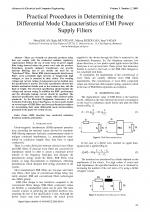| 2/2009 - 10 |
Practical Procedures in Determining the Differential Mode Characteristics of EMI Power Supply FiltersBALAN, H. |
| Extra paper information in |
| Click to see author's profile in |
| Download PDF |
Author keywords
EMI, insertion loss, conducted emissions, frequency analysis, attenuation
References keywords
electromagnetic(5)
No common words between the references section and the paper title.
About this article
Date of Publication: 2009-06-02
Volume 9, Issue 2, Year 2009, On page(s): 65 - 69
ISSN: 1582-7445, e-ISSN: 1844-7600
Digital Object Identifier: 10.4316/AECE.2009.02010
Web of Science Accession Number: 000268723600010
SCOPUS ID: 70349184078
Abstract
There are virtually no electronic products today that can comply with the conducted emission regulatory requirements without the use of some form of power supply filter being inserted where the power cord exits the product. Sometimes, properly designed transformers can provide inherent filtering, and so can obviate the need for an intentional filter. Mains EMI (electromagnetic interference) filters carry potentially high currents at dangerously high voltages, so care is essential in their choice. The working voltage and current rating of components can be decided once the specification is known. The basic specification should also include mechanical details such as the enclosure size, and the limit of weight. The electrical specification should include the voltage and current rating. In addition the EMC performance and the allowable leakage current should be specified. The electrical specification must also comply with national safety standards. In the Electrical Equipment Laboratory of the Technical University from Cluj-Napoca, we have made studies on several types of EMI filters and have performed procedures for determining their main differential mode characteristics, presented in the paper for a study of case. |
| References | | | Cited By |
Web of Science® Times Cited: 1 [View]
View record in Web of Science® [View]
View Related Records® [View]
Updated today
SCOPUS® Times Cited: 2
View record in SCOPUS® [Free preview]
View citations in SCOPUS® [Free preview]
[1] A VLSI Implementation of a New Low Voltage 5th Order Differential Gm-C Low-Pass Filter with Auto-Tuning Loop in CMOS Technology, BOZOMITU, R. G., COJAN, N., Advances in Electrical and Computer Engineering, ISSN 1582-7445, Issue 1, Volume 11, 2011.
Digital Object Identifier: 10.4316/AECE.2011.01004 [CrossRef] [Full text]
[2] Modelling of Switched Mode Fly-back Supply for Engineering Education, TRIP, N. D., LUNGU, S., POPESCU, V., Advances in Electrical and Computer Engineering, ISSN 1582-7445, Issue 1, Volume 10, 2010.
Digital Object Identifier: 10.4316/aece.2010.01018 [CrossRef] [Full text]
Disclaimer: All information displayed above was retrieved by using remote connections to respective databases. For the best user experience, we update all data by using background processes, and use caches in order to reduce the load on the servers we retrieve the information from. As we have no control on the availability of the database servers and sometimes the Internet connectivity may be affected, we do not guarantee the information is correct or complete. For the most accurate data, please always consult the database sites directly. Some external links require authentication or an institutional subscription.
Web of Science® is a registered trademark of Clarivate Analytics, Scopus® is a registered trademark of Elsevier B.V., other product names, company names, brand names, trademarks and logos are the property of their respective owners.
Faculty of Electrical Engineering and Computer Science
Stefan cel Mare University of Suceava, Romania
All rights reserved: Advances in Electrical and Computer Engineering is a registered trademark of the Stefan cel Mare University of Suceava. No part of this publication may be reproduced, stored in a retrieval system, photocopied, recorded or archived, without the written permission from the Editor. When authors submit their papers for publication, they agree that the copyright for their article be transferred to the Faculty of Electrical Engineering and Computer Science, Stefan cel Mare University of Suceava, Romania, if and only if the articles are accepted for publication. The copyright covers the exclusive rights to reproduce and distribute the article, including reprints and translations.
Permission for other use: The copyright owner's consent does not extend to copying for general distribution, for promotion, for creating new works, or for resale. Specific written permission must be obtained from the Editor for such copying. Direct linking to files hosted on this website is strictly prohibited.
Disclaimer: Whilst every effort is made by the publishers and editorial board to see that no inaccurate or misleading data, opinions or statements appear in this journal, they wish to make it clear that all information and opinions formulated in the articles, as well as linguistic accuracy, are the sole responsibility of the author.



